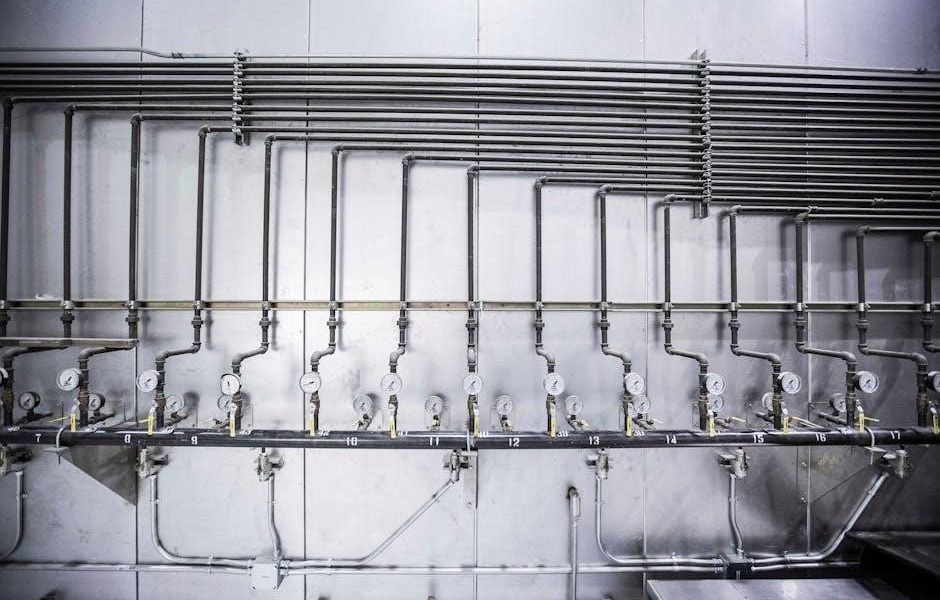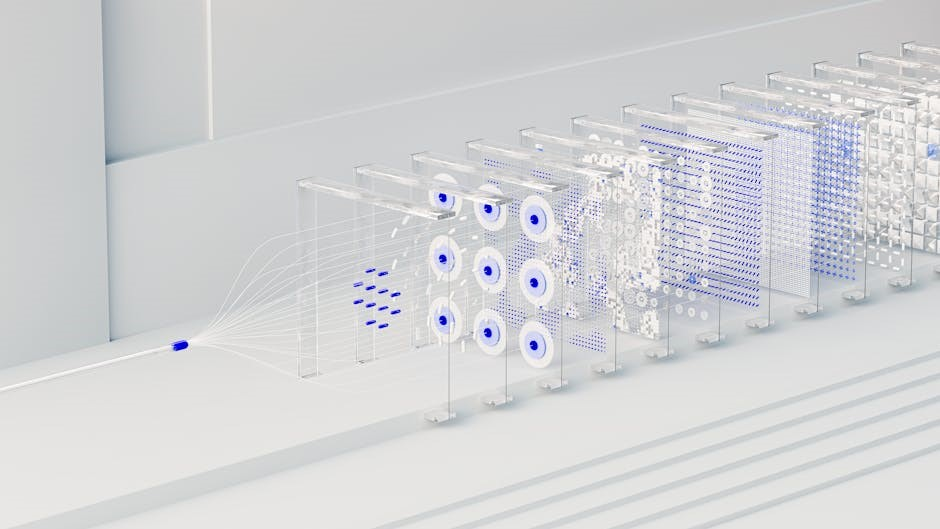
skeletal system pdf
The skeletal system is the internal framework of the human body, providing structural support, protection, and enabling movement. It consists of 206 bones in adulthood, which vary in shape, size, and function, working together with cartilage, ligaments, and tendons to maintain body integrity and facilitate various physiological processes.
1.1 Definition and Overview
The skeletal system is the internal framework of the human body, comprising bones, cartilage, ligaments, and tendons. It provides structural support, protects vital organs, and facilitates movement. At birth, the skeleton includes approximately 270 bones, which fuse during growth, reducing to 206 bones in adulthood. This system is divided into the axial skeleton (central framework) and the appendicular skeleton (limbs and girdles), working together to maintain posture, enable mobility, and safeguard internal organs.
1.2 Importance of the Skeletal System in the Human Body
The skeletal system plays a vital role in maintaining the body’s structure, enabling movement, and protecting internal organs. It serves as a framework for muscle attachment, facilitating motion through joint articulation. Additionally, it houses bone marrow, which produces blood cells essential for oxygen transport and immune function. The skeleton also stores minerals like calcium and phosphorus, supporting overall metabolic health. Its protective function safeguards critical organs, such as the brain and heart, ensuring survival and proper bodily functions.

Structure of the Skeletal System
The skeletal system comprises bones, joints, cartilage, ligaments, and tendons, forming a framework that supports the body, enables movement, and protects vital organs efficiently.
2.1 Bones, Joints, and Cartilage
Bones provide structural support and protection, while joints enable flexible movement between them. Cartilage acts as a cushion, reducing friction and absorbing shock in joints. Ligaments connect bones, stabilizing joints, and tendons attach muscles to bones, facilitating movement. Together, these components form a dynamic system that supports the body, allows for mobility, and protects internal organs, ensuring overall skeletal functionality and integrity.
2.2 Ligaments and Tendons
Ligaments are tough bands of fibrous connective tissue that connect bones to stabilize joints, providing elasticity and strength. Tendons, also made of fibrous tissue, attach muscles to bones, enabling movement by transmitting muscle forces. Together, ligaments and tendons ensure joint stability and facilitate precise, coordinated movements, while protecting the skeletal system from excessive stress or injury, ensuring optimal functionality and mobility.

Divisions of the Skeletal System
The skeletal system is divided into the axial and appendicular skeletons. The axial skeleton includes the skull, spine, ribs, and sternum, while the appendicular comprises the limbs and girdles.
3.1 Axial Skeleton
The axial skeleton forms the body’s central framework, comprising the skull, vertebral column, ribs, and sternum. It includes 80 bones in adults, providing structural support and protecting vital organs such as the brain and thoracic cavity. The skull encloses the brain, while the vertebral column shields the spinal cord. Ribs and the sternum form the thoracic cage, safeguarding the heart, lungs, and major blood vessels. This system is essential for maintaining posture and housing critical bodily systems.
3.2 Appendicular Skeleton
The appendicular skeleton includes the upper and lower limbs, along with the shoulder and pelvic girdles. It comprises 126 bones in adults, enabling movement and locomotion. The girdles attach the limbs to the axial skeleton, while joints allow for a wide range of motion. This system facilitates activities such as walking, running, and manipulating objects, making it essential for interaction with the environment and maintaining an active lifestyle.
Functions of the Skeletal System
The skeletal system provides support, protects internal organs, facilitates movement, and produces blood cells, essential for overall bodily structure and function.
4.1 Support and Protection
The skeletal system acts as the body’s internal framework, providing structural support and maintaining posture. Bones protect vital organs, such as the brain within the skull and the heart within the ribcage. This protective function is crucial for safeguarding delicate tissues from injury. Additionally, the skeleton distributes weight evenly, ensuring stability and preventing damage to internal structures, thereby playing a critical role in overall bodily integrity and functionality.
4.2 Movement and Blood Cell Production
The skeletal system facilitates movement by acting as a framework for muscles to attach to, enabling motion through leverage and joint interaction. Additionally, bones produce blood cells in the bone marrow, a spongy tissue within certain bones, which is vital for oxygen transport, immune defense, and blood clotting. This dual function underscores the skeletal system’s essential role in both locomotion and hematopoiesis, making it a cornerstone of human physiology and overall health.
Types of Bones
Bones are classified based on shape and function, including long, short, flat, and irregular bones. Each type serves specific roles in supporting the body and enabling movement.
5.1 Classification Based on Shape
Bones are categorized into four main types based on their shape: long, short, flat, and irregular. Long bones, like the femur and humerus, are elongated for movement. Short bones, such as carpals and tarsals, provide stability. Flat bones, including the sternum and cranial bones, protect internal organs. Irregular bones, like vertebrae and pelvic bones, have unique shapes for complex functions. Each type adapts to specific roles, ensuring structural integrity and functional efficiency.
5.2 Classification Based on Function
Bones are also classified by their functional roles. Some bones, like the axial skeleton, primarily provide structural support and protect vital organs. Others, such as the appendicular skeleton, facilitate movement by acting as levers for muscles. Certain bones, like the sternum and pelvis, serve dual roles in protection and movement. Additionally, bones like the cranial bones protect the brain, while others, such as the vertebrae, safeguard the spinal cord. This functional diversity ensures optimal body performance and protection.

Bone Density and Development
Bone density peaks around age 21, with genetics and nutrition influencing development. Bones grow through ossification, replacing cartilage with calcified tissue, forming a strong, rigid framework essential for body structure and function.
6.1 Bone Mass and Density
Bone mass, comprising about 14% of total body weight, reaches maximum density around age 21; Genetics and nutrition significantly influence bone density, which gradually decreases with age. Higher density in younger individuals supports strength and movement efficiency, while lower density in older adults increases fracture risks. Maintaining optimal bone density through lifestyle and dietary choices is crucial for long-term skeletal health and overall well-being.
6.2 Bone Growth and Development
Bone growth begins in infancy, with approximately 270 bones at birth. As individuals mature, some bones fuse, reducing the total to 206 in adulthood. Growth occurs through ossification, where cartilage templates are gradually replaced by bone tissue. Hormones, particularly growth hormone, regulate this process. Nutritional factors, such as calcium and vitamin D intake, are vital for healthy bone development. Proper growth ensures optimal skeletal structure and function, supporting the body’s needs throughout life.

Muscular and Skeletal System Connection
The muscular and skeletal systems collaborate to enable movement, with muscles attaching to bones via tendons. Their coordinated contraction and relaxation facilitate motion and provide structural support.
7.1 Role of Muscles in Movement
Muscles play a vital role in movement by working in partnership with bones. Skeletal muscles, attached to bones via tendons, contract and relax to facilitate motion. This interaction enables actions like walking, running, and lifting. Muscles also stabilize joints and maintain posture. The coordinated effort between muscles and the nervous system ensures precise and controlled movements, making physical activities possible and efficient.
7.2 Interaction Between Bones and Muscles
Bones and muscles interact through a complex mechanism to enable movement. Muscles are attached to bones via tendons, forming lever systems. When muscles contract, they pull on bones, creating movement at joints. This interaction is essential for locomotion, posture, and daily activities. The skeletal system provides a stable framework, while muscles generate the force needed for motion, illustrating a harmonious relationship that underpins human mobility and functionality.
Common Skeletal Injuries and Disorders
The skeletal system is prone to injuries like fractures and degenerative conditions such as arthritis or osteoporosis, which impair mobility and overall health.
8.1 Fractures and Their Types
Fractures are breaks in bone continuity, classified by their pattern and severity. Transverse fractures cross the bone horizontally, while oblique fractures create diagonal breaks. Comminuted fractures result in multiple bone fragments, and stress fractures occur due to repetitive strain. Pathological fractures happen in weakened bones, often from diseases like osteoporosis. Proper diagnosis and treatment are crucial to restore function and prevent complications, ensuring the skeletal system resumes its protective and supportive roles effectively.
8.2 Degenerative Conditions
Degenerative conditions affect the skeletal system, reducing its functionality over time. Osteoporosis is a common condition where bones become porous and brittle, increasing fracture risk, especially in the elderly. Osteoarthritis involves cartilage degradation in joints, leading to pain and stiffness. These conditions highlight the importance of maintaining bone health through lifestyle and medical interventions to preserve skeletal integrity and overall well-being.
The skeletal system is vital for human body structure, movement, and protection; Maintaining its health through proper care ensures longevity and overall well-being throughout life.
9.1 Summary of Key Points
The skeletal system, comprising 206 bones, cartilage, ligaments, and tendons, serves as the body’s framework, enabling support, protection, and movement. It protects vital organs, aids in blood cell production, and facilitates growth. The system divides into axial and appendicular skeletons, with bones varying in shape and function. Proper care and nutrition are essential for maintaining bone density and overall skeletal health, ensuring optimal bodily functions and preventing degenerative conditions. Regular exercise and a balanced diet promote strong bones, supporting longevity and well-being.
9.2 Importance of Maintaining Skeletal Health
Maintaining skeletal health is crucial for overall well-being, as it supports bodily functions, protects internal organs, and facilitates movement. A balanced diet rich in calcium and vitamin D, along with regular exercise, helps preserve bone density, reducing the risk of fractures and degenerative conditions like osteoporosis. Prioritizing skeletal health ensures longevity, mobility, and quality of life, making it essential to adopt preventive measures to safeguard this vital system throughout one’s life.
Leave a Reply
You must be logged in to post a comment.